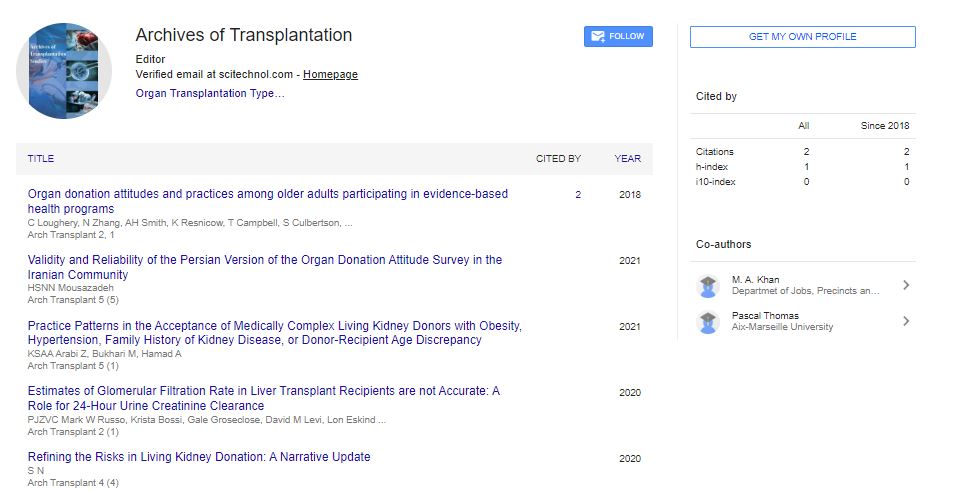Perspective, Arch Transplant Vol: 7 Issue: 4
Assessing the Methods and Strategies of Stem Cell Transplantation
Femio Herbert*
1Department of Neuroscience, University of Copenhagen, 2200 Copenhagen, Denmark
*Corresponding Author: Femio Herbert,
Department of Neuroscience, University
of Copenhagen, 2200 Copenhagen, Denmark
E-mail: femio_herbertut22@gmail.com
Received date: 22 November, 2023, Manuscript No. AT-24-124976;
Editor assigned date: 24 November, 2023, PreQC No AT-24-124976 (PQ);
Reviewed date: 11 December, 2023, QC No. AT-24-124976;
Revised date: 19 December, 2023, Manuscript No. AT-24-124976 (R);
Published date: 26 December, 2023, DOI: 10.4172/AT.1000155
Citation: Herbert F (2023) Assessing the Methods and Strategies of Stem Cell Transplantation. Arch Transplant 7:4.
Description
Stem cell transplantation stands at the forefront of regenerative medicine, providing immense potential for treating a variety of diseases and conditions. The methods and strategies employed in stem cell transplantation, unraveling the complexities, innovations, and implications of this cutting-edge medical approach. Stem cells, with their unique ability to differentiate into various cell types, hold the key to regenerating damaged tissues and organs. Stem cell transplantation involves introducing these cells into a patient's body to replace or repair damaged cells, providing a potential cure or significant improvement for conditions that were once considered incurable.
There are two primary types of stem cell transplantation, autologous and allogeneic. Autologous transplantation involves using a patient's own stem cells, typically harvested from bone marrow or peripheral blood, to facilitate regeneration. Allogeneic transplantation, on the other hand, utilizes stem cells from a donor, often a genetically matched sibling or unrelated donor. The method of stem cell harvesting is an essential aspect of transplantation. Bone marrow, the spongy tissue found within bones, is a common source of stem cells. A needle is used to extract a small amount of bone marrow, which is then processed to isolate the stem cells. Peripheral blood stem cell harvesting involves stimulating the release of stem cells from the bone marrow into the bloodstream using growth factors.
The cells are then collected through apheresis, a process that separates stem cells from blood components. Embryonic and adult stem cells represent two fundamental categories. Embryonic stem cells, derived from embryos, have the potential to differentiate into any cell type in the human body. However, ethical considerations surround their use. Adult or somatic stem cells are found in various tissues throughout the body and are more limited in their differentiation potential. Despite these limitations, adult stem cells are widely used in transplantation due to their availability and reduced ethical concerns. Stem cell transplantation strategies vary based on the intended therapeutic outcome. In tissue-specific repair, stem cells are directed toward a particular lineage to replace or repair damaged cells in specific organs or tissues.
For example, in cardiac repair, stem cells may be guided to differentiate into heart muscle cells, promoting the regeneration of damaged cardiac tissue. One of the challenges in stem cell transplantation is the potential for the recipient's immune system to reject donor cells. Immunosuppressive strategies are employed to manage this response. In allogeneic transplantation, patients receive immunosuppressive medications to prevent graft-versus-host disease, a condition where donor cells attack the recipient's tissues. Striking a delicate balance between preventing rejection and preserving immune function is a key consideration in successful stem cell transplantation.
Recent advancements in gene editing technologies, such as CRISPR-Cas9, have opened new possibilities for enhancing the effectiveness of stem cell transplantation. Experts can now edit the genetic makeup of stem cells to improve their therapeutic potential, address genetic disorders, or make them more resistant to immune rejection. While the potential benefits of stem cell transplantation are the innovative challenges persist. Ethical concerns surround the use of embryonic stem cells, necessitating the development of alternative approaches. Additionally, long-term effects and potential complications, such as tumor formation or unexpected differentiation, require thorough investigation.
Conclusion
Stem cell transplantation represents a frontier in medical science, providing unprecedented opportunities for regenerative medicine. The methods and strategies employed in this field continue to evolve, with ongoing studies pushing the boundaries of what is possible. As analysts navigate the complexities of tissue-specific repair, immunomodulation, and gene editing, the potential of stem cell transplantation as a transformative medical intervention becomes increasingly tangible. While challenges and ethical considerations remain, the journey toward unlocking the full potential of stem cell transplantation holds immense potential for the future of healthcare and regenerative medicine.
 Spanish
Spanish  Chinese
Chinese  Russian
Russian  German
German  French
French  Japanese
Japanese  Portuguese
Portuguese  Hindi
Hindi 